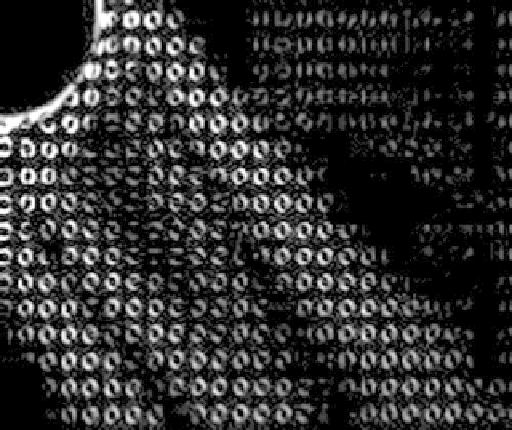Geoscience Reference
In-Depth Information
Consider Figure 10.6, which shows the
N
2
field com-
puted using synthetic schlieren for an oscillating cylinder
experiment. Imagining a Cartesian grid superimposed on
the wave field with the origin at the center of the dis-
turbance, the four arms of the cross consist of upward
propagating waves emanating rightward and leftward in
the first and second quadrants, respectively, and of down-
wardpropagatingwavesemanatingleftwardandrightward
in the third and fourth quadrants, respectively. Hilbert
transforms can extract each arm of the cross, as shown in
Figure 10.7.
In application, the method does not formally com-
pute the Cauchy principle value integral associated with a
Hilbert transform. Instead, it employs filtering of Fourier
transform images, specifically those of time series of the
disturbances. For example, consider a synthetic schlieren
employing an image of horizontal black-and-white lines
behind a tank. During the evolution of a spanwise-
uniform disturbance, one can compute
N
2
(x
,
z
,
t)
,in
which
z
is vertical,
x
is the along-tank coordinate, and
t
is
time. Fixing an arbitrary horizontal location
X
, one can
construct the vertical time series
N
2
(z
,
t
;
x
=
X)
. Taking
the double fast Fourier transform first in
t
and then in
z
gives the complex series coeficients
N
2
(k
z
,
ω)
,inwhich
k
z
is the vertical wave number and
ω
is the frequency.
To extract upward propagating disturbances, we use the
fact that the group velocity of internal waves is positive
if the vertical wave number is negative. So we set
N
2
to zero if
k
z
is positive and leave the field untouched
otherwise. An inverse Fourier transform then produces
a filtered field
N
2
Figure 10.4.
Pattern of internal waves generated by an oscil-
lating cylinder in the upper left-hand corner as visualized by
qualitative synthetic schlieren applied to a pattern of equally
spaced dots behind the tank. Adapted from Figure 7c of
Dalziel
et al.
[2000].
resulting elliptical disturbance give both components of
the perturbation density gradient. Multiplying by
g/ρ
0
,
as in equation (10.9), the perturbation density gradient
may be recast in terms of the perturbation squared buoy-
ancy frequency:
(N
2
x
,
N
2
z
)
−
ρ
.
Alternately, if the image of dots is randomly distributed,
then particle image velocimetry techniques can be used
to measure horizontal and vertical displacements of por-
tions of the image [
Dalziel et al.
, 2000]. Assuming the dis-
turbance in the ambient is uniform along the line of sight,
each displacement field can be used to find the perturba-
tion density gradient. This can be integrated to compute
the perturbation density field, as shown in Figure 10.5.
≡−
(g/ρ
0
)
∇
(z
,
t
;
x
=
X)
with only upward prop-
agating disturbances. This process can be repeated at
different horizontal locations until the entire evolution
field of upward propagating disturbances is reproduced:
N
2
↑
(x
,
z
,
t)
.
We can similarly extract rightward propagating waves
by Fourier transforming horizontal time series at succes-
sive
z
=
Z
, setting the coefficients of negative horizontal
wave numbers to zero and then inverse transforming. The
result of applying this to
N
2
↑
, for example, gives the up
and rightward wave beam shown in the top-left panel of
Figure 10.7.
↑
10.3.2. Separating Up from Down and Left from Right
A powerful analysis tool related to Hilbert transforms
can be used to distinguish upward from downward propa-
gating internal waves and simultaneously distinguish left-
ward from rightward propagating waves [
Mercier et al.
,
2008]. This can be applied to vertical or horizontal time
series constructed from simulations, in situ observations,
and laboratory experiments. Whether spanwise uniform,
axisymmetric, or fully three dimensional, the method can
distinguish propagation direction in the spatial compo-
nent of the time series. Its application will be discussed
here in the context of internal waves generated by an
oscillating cylinder.
10.3.3. Partial Transmission and Reflection
The use of the Hilbert transform method described
above has proven to be particularly useful in the study of
internal wave propagation in nonuniformly stratified fluid.
The intuitive understanding of their propagation is based
upon ray theory, which assumes the small-amplitude
wavepackets are quasi-monochromatic and that the back-
ground varies slowly compared to the wavelength [e.g.,
see
Lighthill
, 1978;
Sutherland
, 2010]. In particular, in a
stationary fluid this predicts that waves reflect from a level
















